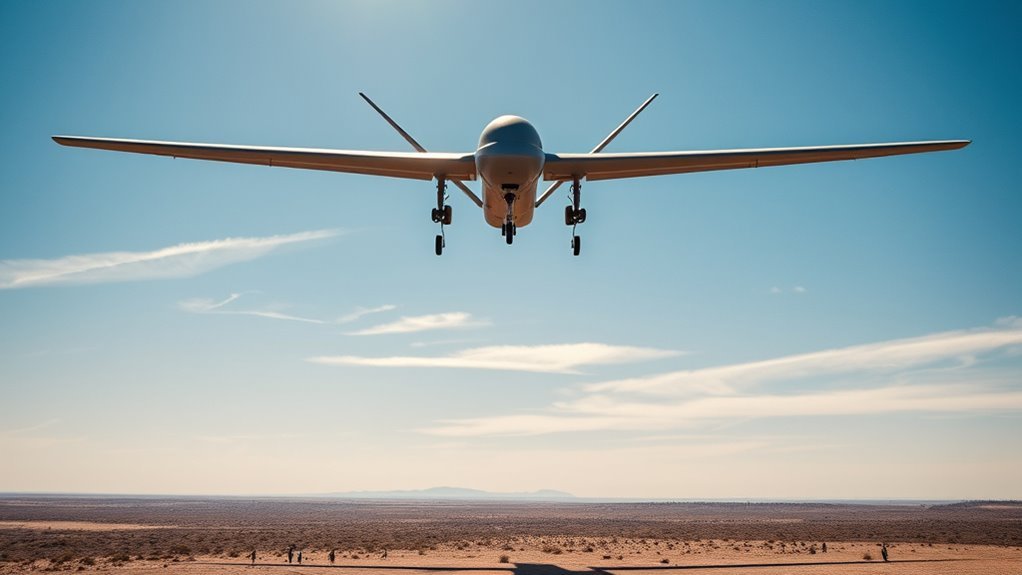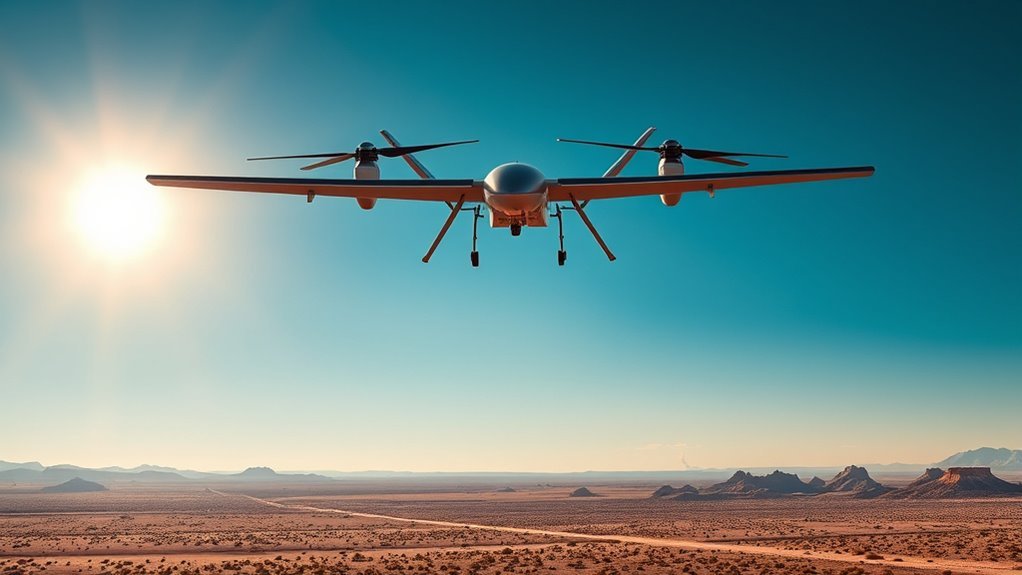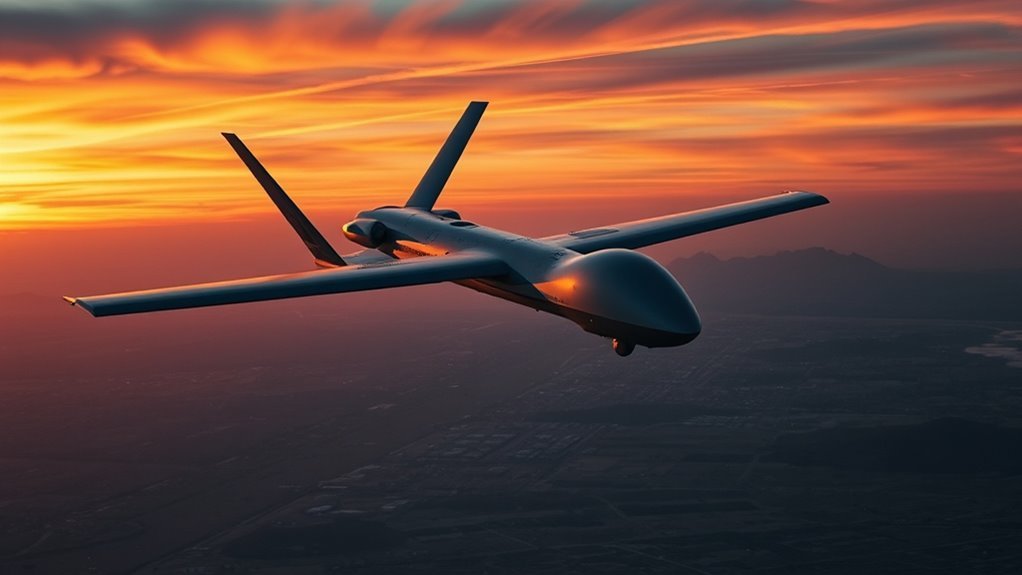Military drones typically have flight durations ranging from 9 to 34 hours, depending on the model and mission objectives. Factors such as payload weight, battery capacity, and environmental conditions can greatly impact endurance. For instance, the MQ-1 Predator can fly for 24 hours, while the RQ-4 Global Hawk boasts 34 hours. As technology advances, future drones may achieve even longer flight times. Discovering more about these capabilities reveals exciting developments in military drone technology.
Overview of Military Drone Flight Endurance

Military drones, often referred to as unmanned aerial vehicles (UAVs), exhibit a range of flight endurance capabilities influenced by their design and mission profiles. Their drone efficiency is paramount, impacting not just operational costs but also strategic effectiveness. For instance, endurance directly correlates to the UAV’s surveillance capabilities, allowing for prolonged reconnaissance missions without the need for frequent refueling or repositioning. Certain models can sustain flight for over 24 hours, ensuring thorough coverage of targeted areas. This extended endurance enables military forces to maintain a persistent presence, gather critical intelligence, and respond swiftly to emerging threats. Additionally, advances in AI-driven autonomy enhance the operational capabilities of these drones, allowing for more efficient mission execution. Ultimately, understanding flight endurance is essential for optimizing mission planning and enhancing overall operational effectiveness in achieving strategic objectives.
Factors Influencing Flight Duration

While various factors can affect the flight duration of military drones, design specifications and operational parameters play essential roles. You should consider several key elements that influence how long a drone can stay airborne:
- Payload weight: Heavier loads reduce flight time.
- Battery capacity: Larger batteries extend endurance, which is crucial for maximizing flight time.
- Flight conditions: Weather and altitude impact performance.
- Aerodynamics: Design shape affects fuel efficiency.
- Mission objectives: Specific tasks can dictate energy usage.
Understanding these factors helps you appreciate the complexities involved in drone operations. By optimizing each aspect, military forces can maximize flight duration to achieve mission objectives effectively, even under varying flight conditions. Ultimately, these considerations are critical for mission success and operational flexibility. Additionally, battery endurance plays a significant role in determining flight times and maximizing operational effectiveness for military drones.
Comparison of Popular Military Drone Models

When evaluating military drones, you’ll find a diverse range of models, each designed for specific operational needs and environments. Here’s a comparison of popular military drone models that showcases their drone specifications and military applications:
| Drone Model | Flight Time | Payload Capacity |
|---|---|---|
| MQ-1 Predator | 24 hours | 450 lbs |
| MQ-9 Reaper | 27 hours | 3,000 lbs |
| RQ-4 Global Hawk | 34 hours | 1,500 lbs |
| RQ-7 Shadow | 9 hours | 35 lbs |
Understanding these specifications helps you assess which drone best fits your needs, whether for surveillance, reconnaissance, or targeted strikes. Each model’s unique flight duration and payload capacity highlight its suitability for various military applications.
Technological Advancements in Drone Endurance
You’ll find that advancements in battery technology and solar power integration are vital for enhancing drone endurance. These innovations not only extend flight times but also optimize energy efficiency, allowing for longer missions. Understanding these developments is essential for evaluating the operational capabilities of modern military drones. Furthermore, advanced battery optimization techniques play a crucial role in managing power consumption efficiently, enabling longer flights without interruptions. Additionally, energy management systems are essential for extending operational time by up to 30%.
Battery Technology Improvements
As advancements in battery technology continue to evolve, military drones are experiencing significant improvements in endurance and operational capabilities. Enhanced battery efficiency and energy density are pivotal in extending flight times, allowing drones to conduct longer missions without the need for frequent recharges.
- Lightweight materials are reducing overall drone weight.
- Lithium-sulfur batteries offer higher energy density than traditional lithium-ion.
- Fast-charging capabilities minimize downtime.
- Innovations in solid-state batteries increase safety and longevity.
- Energy harvesting technologies complement battery power.
These improvements not only enhance mission effectiveness but also provide military operators more freedom in strategic planning and execution. With each leap in battery technology, the potential for drone applications expands, paving the way for a more efficient aerial force.
Solar Power Integration
Recent advancements in solar power integration are revolutionizing the endurance capabilities of military drones. By harnessing solar energy, drones can considerably extend their operational flight times without solely relying on traditional battery systems. This integration enhances drone efficiency, allowing for longer missions and reduced logistical burdens associated with fuel and battery replacements.
Solar panels incorporated into drone designs capture sunlight during flight, converting it into usable energy that powers onboard systems. This innovation not only increases endurance but also provides a sustainable energy source, aligning with the desire for freedom in operational capabilities. As military applications evolve, the role of solar energy in drone technology will likely become a critical factor in optimizing performance and extending mission durations.
Real-World Examples of Drone Flight Times
While various factors influence the flight times of military drones, real-world examples provide valuable insights into their operational capabilities. Consider the following:
- The MQ-1 Predator can sustain drone missions for up to 24 hours.
- The MQ-9 Reaper typically has a flight time of about 14 hours, allowing for extensive surveillance.
- The Global Hawk boasts an impressive 34-hour endurance, ideal for long-range missions.
- The RQ-7 Shadow is designed for shorter missions, averaging around 6 hours.
- Various drone flight patterns enhance mission success, adapting to specific operational needs.
These examples illustrate how operational requirements dictate flight times, reflecting the strategic roles drones play in modern warfare and their capacity to execute diverse drone missions effectively.
The Role of Payload in Flight Endurance
When evaluating flight endurance, the weight of the payload plays a critical role in determining how long a military drone can remain aloft. Different types of payloads, whether for surveillance or munitions, also influence energy consumption and overall efficiency. Understanding these factors is essential for optimizing flight endurance in various operational scenarios.
Impact of Payload Weight
As you consider the flight endurance of military drones, it is essential to understand how payload weight considerably impacts their operational capabilities. The balance between payload and flight time is important, as heavier payloads can diminish endurance.
- Payload optimization is key for maximizing flight duration.
- Effective weight distribution influences stability and maneuverability.
- Increased weight requires more energy, reducing overall flight time.
- Different missions may necessitate varying payload configurations.
- Understanding the trade-offs between payload and endurance can enhance operational effectiveness.
Types of Payloads
Understanding the types of payloads that military drones can carry is essential for evaluating their flight endurance. Different payload types—such as surveillance equipment, weapons, or electronic warfare systems—can greatly influence how long a drone remains airborne. For instance, a drone equipped with lightweight sensors may achieve longer flight times than one loaded with heavy munitions. Payload versatility also plays an important role; drones designed to switch between various types of payloads can adapt their missions, but this flexibility often comes at the cost of endurance. Consequently, a drone’s operational effectiveness directly correlates with the balance it strikes between payload weight and the mission requirements, ultimately affecting its flight duration and overall performance in the field.
Optimizing Flight Endurance
To optimize flight endurance, the payload carried by military drones must be carefully considered, as it directly impacts operational performance. When weighing your options, keep in mind the following factors:
- Weight Distribution: Balance is essential for maintaining flight stability.
- Type of Sensors: Advanced sensors can enhance mission effectiveness but may increase weight.
- Fuel Efficiency: Payload choices should optimize fuel consumption for longer missions.
- Mission Profile: Tailor payloads based on specific mission requirements for better performance.
- Endurance Strategies: Implement strategies that allow for flexible payload adjustments depending on situational needs.
Future Trends in Military Drone Flight Technology
While advancements in military drone flight technology are rapidly evolving, several key trends are poised to shape their future capabilities. You’ll see an increase in autonomous navigation, enabling drones to operate with minimal human intervention. This shift not only enhances operational efficiency but also reduces the risk to personnel. AI integration is another significant trend, allowing drones to process vast amounts of data in real-time, improving decision-making and target acquisition. Furthermore, advancements in propulsion systems will likely extend flight endurance, making long-duration missions more feasible. As these technologies converge, military drones will become more versatile and capable, ultimately supporting the need for enhanced strategic autonomy and operational flexibility in complex environments. Additionally, the integration of advanced AI and autonomous navigation will further drive the demand for sophisticated drone capabilities in defense applications. Embracing these changes will be essential for maintaining a competitive edge. With AI-enhanced obstacle avoidance features, military drones will be better equipped to navigate complex environments safely.
Frequently Asked Questions
What Are the Legal Restrictions on Military Drone Flight Duration?
When considering military drone operations, you must understand the legal implications and operational guidelines. These regulations can restrict flight duration based on mission type, airspace, and compliance with international laws, ensuring ethical engagement.
How Do Weather Conditions Affect Military Drone Flight Times?
Weather’s whims wield a weighty influence on flight efficiency. Rainy regions reduce range, while strong winds stifle stability. Understanding weather impact’s intricacies helps you grasp how conditions fundamentally dictate military drone capabilities and operational effectiveness.
Can Military Drones Be Refueled In-Flight?
Yes, military drones can utilize in-flight refueling to extend their endurance considerably. This capability allows them to remain operational longer, enhancing mission effectiveness while reducing the limitations of conventional fuel capacities and flight time constraints.
What Safety Measures Are in Place for Drone Operations?
In 2022, over 80% of drone incidents stemmed from operational failures. To mitigate risks, military operations implement stringent drone safety protocols, ensuring thorough risk management and continuous training, ultimately safeguarding personnel and mission integrity.
How Are Drone Flight Times Monitored and Reported?
You’ll find that flight data is meticulously tracked using advanced monitoring systems. These systems provide real-time updates, ensuring accurate reporting on drone operations, which enhances safety and efficiency in military applications while maintaining operational transparency.

